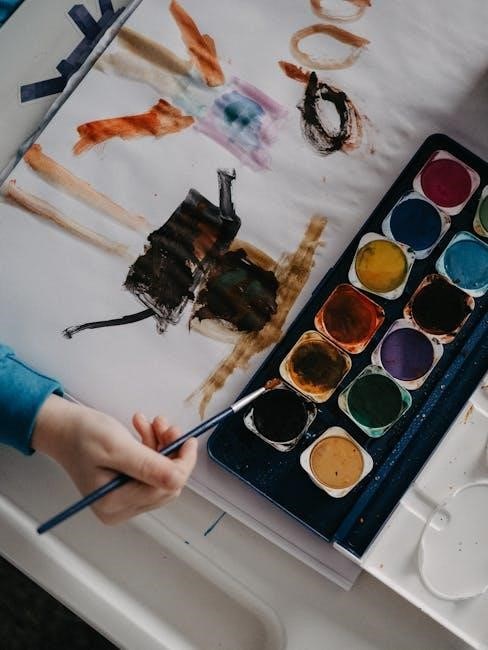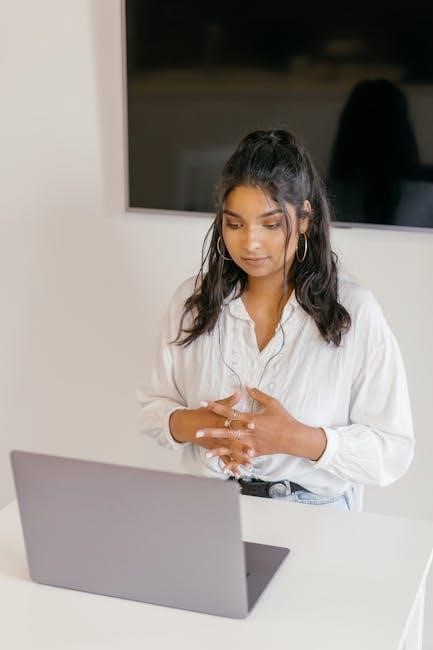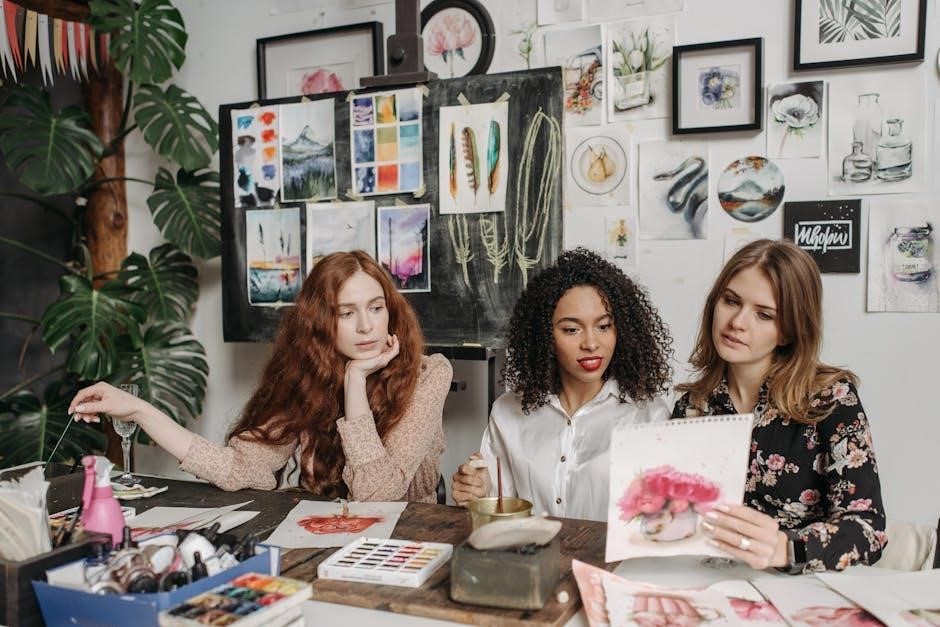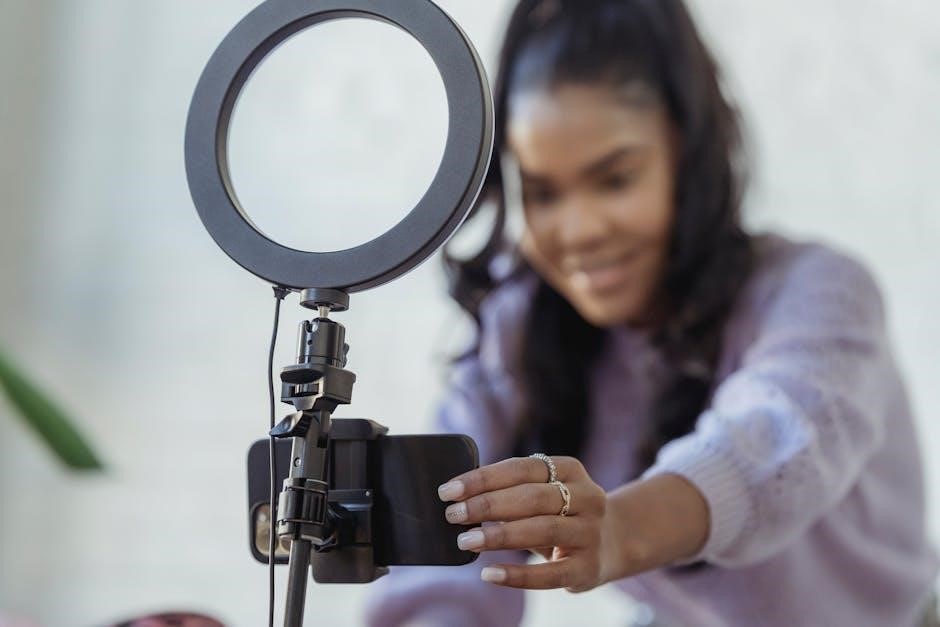watercolor tutorial pdf

Watercolor Tutorial PDF: A Comprehensive Guide
Unlocking the world of watercolor painting is now easier than ever with comprehensive PDF guides. These resources offer structured lessons, techniques, and tips for beginners and experienced artists alike. Explore step-by-step instructions and downloadable templates to enhance your skills.
Watercolor painting, a captivating medium, offers boundless creative avenues. Its fluid and adaptable nature yields unexpected results, mirroring the artist’s unique style. From picturesque landscapes to expressive character illustrations, watercolor captures diverse subjects with ease. Free tutorials and downloadable PDFs provide a perfect foundation for beginners. Learn essential supplies, mixing techniques, and practice simple elements like leaves and flowers.
Explore the beauty and spontaneity of watercolor, mastering fundamentals and special techniques through step-by-step demonstrations. These guides cater to aspiring artists, walking them through the watercolor process. Discover how to paint skies, trees, water, buildings, and flowers with easy-to-follow lessons. This introduction unveils the magic of watercolor, inviting you to embark on a colorful artistic journey.
Dive into the world of washes, blends, and layering techniques. Experiment with lifting and masking to achieve stunning effects. Watercolor offers endless possibilities for artistic expression. Whether you’re a beginner or an experienced artist, there’s always something new to discover. Embrace the fluidity and transparency of this versatile medium, and watch your creativity flourish.
Benefits of Learning Watercolor
Learning watercolor painting offers a multitude of benefits, extending beyond artistic expression. It fosters creativity and enhances observational skills, encouraging you to see the world with a new perspective. The fluid nature of watercolor promotes mindfulness and relaxation, providing a therapeutic outlet for stress relief. As you experiment with colors and techniques, you’ll develop problem-solving abilities and learn to embrace imperfection.
Watercolor painting is a portable and accessible art form, requiring minimal supplies and space. This allows you to create art anywhere, anytime, nurturing your creative spirit on the go. The transparency of watercolor encourages layering and blending, teaching you about color theory and composition. The process of learning watercolor cultivates patience and perseverance, as you refine your skills over time.
Furthermore, watercolor painting can boost your self-esteem and confidence as you witness your artistic growth. Sharing your creations with others fosters connection and community. Whether you aspire to be a professional artist or simply enjoy a creative hobby, learning watercolor enriches your life in countless ways. It opens doors to self-discovery, artistic fulfillment, and a deeper appreciation for the world around you.

Essential Watercolor Supplies for Beginners
Embarking on your watercolor journey requires a few essential supplies. These include quality paints, suitable brushes, and appropriate paper. Selecting the right materials will significantly impact your experience and the outcome of your artwork, making the process more enjoyable.
Paints: Types and Quality
Watercolor paints are available in various forms, including tubes and pans, each offering distinct advantages. Tubes provide more control over paint consistency and are ideal for larger washes. Pans are convenient for portability and quick sketches. Student-grade paints are affordable, but professional-grade paints offer superior pigment concentration and lightfastness.
Consider investing in artist-quality paints as your skills progress. High-quality pigments result in vibrant colors that resist fading over time. Look for paints with good transparency, allowing for layering and glazing techniques. Experiment with different brands to find your preferred consistency and color range.
When starting, a limited palette of primary colors (red, yellow, blue) is sufficient. You can mix a wide range of hues from these foundational colors. Gradually expand your palette as you become more comfortable with color mixing. Remember that the quality of your paints directly affects the vibrancy and longevity of your artwork.
Brushes: Selection and Care
Choosing the right watercolor brushes is essential for achieving desired effects. Round brushes are versatile for detail work and washes. Flat brushes are ideal for creating broad strokes and even washes. Filbert brushes offer a combination of both, with rounded edges suitable for blending and softening edges.
Synthetic brushes are affordable and durable, while natural hair brushes, like sable or squirrel, hold more water and offer smoother application. Consider a variety of sizes to accommodate different painting scales and techniques. Proper brush care is crucial for longevity.
Clean brushes thoroughly after each use with mild soap and water. Reshape the bristles and allow them to dry horizontally to prevent water from seeping into the ferrule. Avoid storing brushes upright, as this can damage the bristles. With proper care, your brushes will remain in excellent condition for years to come, ensuring consistent performance and optimal results in your watercolor paintings. Investing in quality brushes is an investment in your artistic journey.
Paper: Choosing the Right Surface
Selecting the appropriate paper is vital for successful watercolor painting. Watercolor paper is categorized by weight, texture, and composition. Weight, measured in pounds (lbs) or grams per square meter (gsm), indicates thickness; heavier paper resists buckling and warping when wet. 140lb (300gsm) is a standard choice for beginners, while heavier options like 300lb (640gsm) are suitable for more demanding techniques.

Texture varies from hot press (smooth) to cold press (medium texture) to rough (highly textured). Hot press paper is ideal for detailed work, while cold press offers a balance of smoothness and texture. Rough paper is best for creating dramatic effects. Composition refers to the materials used; cotton rag paper is archival and durable, offering superior water absorption and color vibrancy compared to wood pulp paper.
Experiment with different types to discover your preferred surface. Consider factors such as your painting style, desired level of detail, and budget. Investing in quality paper enhances your artwork and prevents frustration.

Basic Watercolor Techniques
Mastering fundamental watercolor techniques is key to creating beautiful paintings. Learn essential methods such as washing, blending, dry brushing, layering, lifting, and masking to achieve various effects and textures in your artwork. Practice these for best results.
Washing and Blending
Washing and blending are fundamental watercolor techniques crucial for creating smooth transitions and luminous effects. A wash involves applying a diluted layer of paint to the paper, creating a base or background. This technique requires a soft brush and plenty of water to achieve an even, transparent color. Experiment with different dilutions to control the intensity of the wash.
Blending, on the other hand, focuses on seamlessly merging colors together. This can be achieved by applying wet paint next to wet paint, allowing the colors to naturally mix on the paper. Another method involves softening the edges of a painted area with a clean, damp brush, creating a gradient effect.
Practice is key to mastering these techniques. Start with simple gradients, gradually increasing the complexity of your blends. Pay attention to the amount of water you use, as too much can lead to uncontrolled blooms, while too little can result in harsh lines. With patience and persistence, you’ll be able to create stunning, atmospheric washes and blends in your watercolor paintings.
Dry Brushing and Layering
Dry brushing and layering are essential watercolor techniques for adding texture, depth, and detail to your paintings. Dry brushing involves using a brush with very little water to create a broken, textured effect; This technique is ideal for depicting rough surfaces like rocks, tree bark, or grass. Load your brush with paint, then blot it on a paper towel until it’s almost dry before applying it to the paper.
Layering, also known as glazing, involves applying thin, transparent washes of color on top of each other. This technique allows you to build up depth and complexity in your painting, creating subtle variations in color and value. Allow each layer to dry completely before applying the next to prevent muddying the colors.
Experiment with different combinations of dry brushing and layering to achieve a variety of effects. Use dry brushing to add texture to a layered background, or layer different colors to create a luminous, atmospheric effect. With practice, you’ll be able to use these techniques to add dimension and realism to your watercolor paintings.
Lifting and Masking
Lifting and masking are invaluable watercolor techniques for preserving white areas and creating interesting effects. Lifting refers to the process of removing paint from the paper after it has been applied, allowing you to lighten areas or create highlights. This can be done with a clean, damp brush or a sponge, gently blotting the area you wish to lighten. The success of lifting depends on the type of paper and paint used; some pigments stain more than others.
Masking, on the other hand, involves protecting certain areas of the paper from paint. This is typically done with masking fluid, a liquid latex product that is applied to the paper and allowed to dry. Once dry, you can paint over the masked area without affecting the protected surface. After the paint is dry, the masking fluid can be gently removed, revealing the untouched paper beneath.
Masking is particularly useful for creating sharp edges, intricate patterns, or preserving delicate details. Experiment with both lifting and masking to add depth and complexity to your watercolor paintings. These techniques provide greater control and allow for creative problem-solving.

Free Resources for Learning Watercolor
Discover a wealth of free resources to master watercolor painting! Explore online tutorials, downloadable PDF guides, and open-source image libraries. Elevate your skills with readily available learning materials without spending a dime, and unlock your artistic potential today!
Online Tutorials and Courses
Embark on your watercolor journey with a plethora of online tutorials and courses designed for all skill levels. Many platforms offer free introductory lessons, perfect for grasping the fundamentals. Dive into comprehensive courses that cover everything from basic techniques to advanced detailing effects, guiding you step-by-step through skies, trees, and floral elements.
Explore various online resources, including video tutorials and structured courses, often taught by experienced artists. These platforms provide flexible learning schedules, allowing you to progress at your own pace. Some courses may even offer downloadable workbooks and templates to supplement your learning, ensuring a well-rounded educational experience.
Additionally, keep an eye out for free ebooks and guides that complement these tutorials, offering further insights and inspiration. With the abundance of resources available online, mastering watercolor painting has never been more accessible. Take advantage of these opportunities to enhance your skills and unleash your creativity.
Free Watercolor PDF Guides and E-books
Discover a treasure trove of knowledge with free watercolor PDF guides and e-books, perfect for deepening your understanding and honing your skills. These resources offer a wealth of information, ranging from basic techniques to advanced projects, often including step-by-step instructions and visual examples.
Many artists and organizations provide these guides as a way to share their expertise and inspire others. Look for e-books that cover specific topics, such as color mixing, brush techniques, or painting different subjects like landscapes and florals. These PDFs often include downloadable templates and exercises to practice your skills.
Additionally, explore online platforms and communities dedicated to watercolor painting, where you can find a variety of free resources and connect with other artists. These guides can be an invaluable tool for both beginners and experienced painters looking to expand their knowledge and refine their techniques. Take advantage of these free resources to unlock your artistic potential.
Libraries and Open Source Images
Enhance your watercolor journey by leveraging the vast resources available through libraries and open-source image platforms. Libraries offer a wealth of books and resources on watercolor techniques, art history, and color theory, providing a strong foundation for your artistic development. Many libraries also provide online access to e-books and digital resources.
Open-source image platforms, such as Pixabay and Unsplash, offer a vast collection of high-resolution images that can serve as inspiration and reference material for your watercolor paintings. These platforms provide royalty-free images that you can use for practice, studies, or even as the basis for your own original artwork.
Furthermore, explore digital archives of museums and galleries, like the National Gallery, which often provide open access to high-quality images of artwork. By utilizing these resources, you can access a diverse range of visual references to inspire your creativity and improve your watercolor skills.